
Nice read!
Jun 26, 2024
The Pony Express was able to deliver mail over 2,000 miles in only 10 days, entirely on horseback. This was accomplished by swapping onto a new horse every 10-15 miles, enabling the rider to always travel at a full gallop. The horse exchange took a maximum of two minutes, and riders themselves would also swap out every 150-200 miles, which enabled the delivery to keep moving forward 24 hours a day.
By comparison to the Pony Express’s 121 riders and 500 horses, I'm both the only rider and the only horse. My steed, Teeder, is a one-wheel-drive ATV who can take you just about anywhere you have the will to pedal her.
While the Pony Express had its western terminus in Sacramento, I was starting from Oakland, mostly because I wanted to visit a good friend who lived there. It also meant I’d get a warm-up day before the ride “officially” began.
As it turned out, a shakedown ride was a great idea! Only minutes after riding away from the airport, it became obvious there was something wrong with my saddle and/or seatpost. Almost any bump would cause the saddle to dramatically tilt up or down, and that caused the seat pack to drop onto the rear tire. Chances are TSA tried lifting Teeder by the saddle when they inspected the box, and that messed everything up.
The bolt which needed to be adjusted happened to be the only bolt on Teeder which required a torx wrench, something I'd decided not to bring, since it was highly unlikely I’d need it. Luckily, the problem was discovered while I was in a town with plenty of bike shops. I found one nearby, and within minutes, the problem was fixed, free of charge.
Bike shops are awesome. Can you imagine a doctor or a hospital doing that? For a similar problem, they’d make you set an appointment weeks in advance, fill out three pages of paperwork, spend more time waiting for the doctor than seeing the doctor, and then charge you $300+ for five minutes of “work.” If a bike shop can provide this level of service without going out of business, why can’t smart people like doctors and hospitals do the same?
Less than two blocks from leaving my friend’s house in Oakland, at 7:00 AM on a Friday morning, there was a fully nude woman walking down the street. Oh, San Francisco Bay, you slay me.
I’d thought the day would mostly involve a big climb out of the bay area, and then a lot of rural riding for most of the day. Instead, the climb out of the bay was much smaller than expected, most of the day was relatively flat, and it didn’t feel like I’d fully left the bay area until I’d gone at least 60 miles (100 km).
Davis, CA is a mid-sized college town, known for its bike-friendliness, even compared to other college towns. In other words, it’s my idea of paradise.
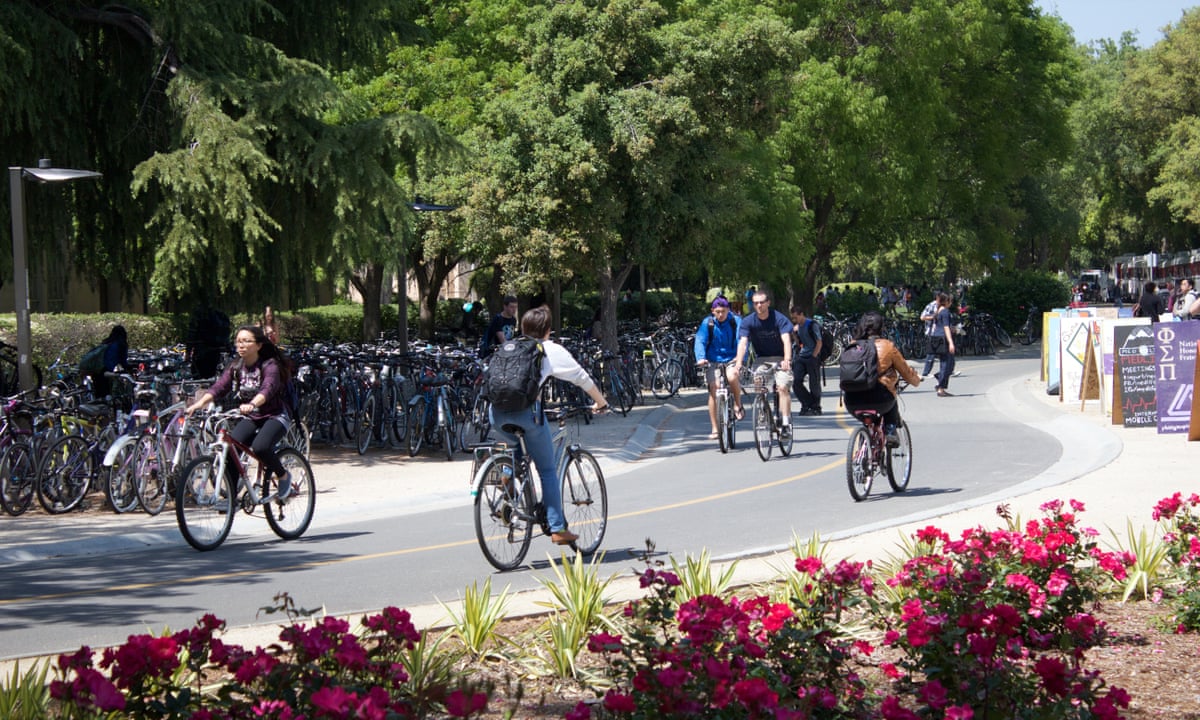
Despite being home to about a dozen WarmShowers hosts, I was unable to find one in Davis. I guess that’s what you get when you start a tour on a holiday weekend. Once in Davis, I asked around town if there was a place I could sleep on the floor or set up a tent, but no one was able to help. There was still plenty of daylight, so I could’ve ridden the 15 miles (25 km) to Sacramento, but I would’ve had the same problem there.
Instead, I took in the first half of an outdoor theatre production, then snuck off to a secret spot, in between a jogging trail and a golf course, and set up the tent just at dark. It wound up being a highly comfortable first night on the trail.
I would be remiss if I didn’t mention that a few folks from the theatre company gave me a fried chicken sandwich. And ho-ly crap was it ever satisfying. Day 1 ended on a high note.
At 8:00 AM on a Saturday, I saw a guy in Sacramento riding a bike with no front tire. Bare metal rim on asphalt. I felt bad for the guy, but also admired him. What is it with seeing weird things early in the morning in California?
For one reason or another, I decided to “officially” start from Sacramento at high noon. That meant I had a few hours to kill. Visited the capitol, finished my book (which wasn’t that good) and ditched it to save weight. Made my way over to old downtown, found the Pony Express statue, and stared at a clock for a while. The clock struck noon and I began.
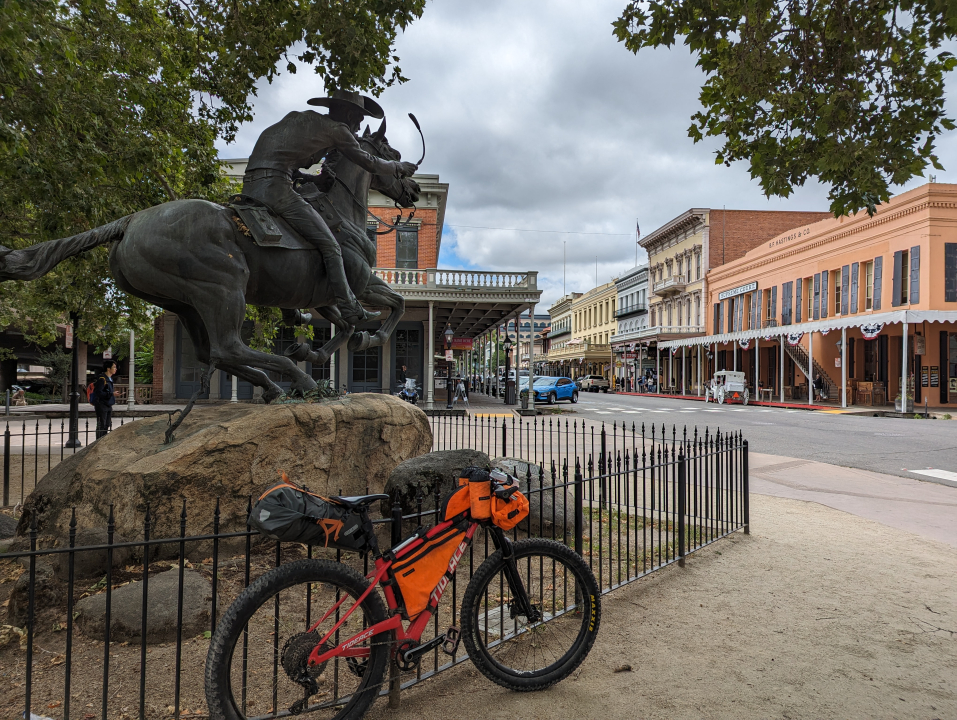
The first 30 miles (50 km) of the Pony Express route are on a gorgeous, well-designed bike path, known as the American River Trail in Sacramento and the Jedediah Memorial Trail as you go further east. The trail follows the American River while frequently staying underneath large shade trees. The tufts falling out of the cottonwoods almost made it feel like it was snowing on a warm, sunny Saturday. Thousands of people were out enjoying the trail and the river. When non-motor infrastructure gets built, it gets used!

The trail effectively ends in Folsom, a town whose own bike path was closed indefinitely for repair. Can you imagine that happening to a roadway? What if a town had only one roadway, and it was closed entirely for months at a time. Not a lane closure, a complete closure, with no detour or alternate route. That’s entirely unacceptable, and it’s equally unacceptable for every other means of transportation. When it comes to transportation, anyone without a car is a 2nd-class citizen. Somehow, we never have the budget for bike paths, buses, or rails, but we’ll provide a comprehensive road networks and hundreds of acres of car parking, both for free. Never mind that car infrastructure is more expensive by a factor of dozens, if not hundreds. Cars are important. Nothing else is.
Upon leaving Folsom is where the route starts to climb, mostly on side roads. I’ve made the drive up to Tahoe several times, but always on the highway. For the first time, I saw the cool towns all along the way up; Orchards, vineyards, patio restaurants. I kept wanting to stop and check them out! Between El Dorado and Placerville is a nice trail, evidently a rail-trail, but much steeper than you’d expect. It’s hard to imagine a train making it up that kind of grade; I wondered what the story was there.
The Eldorado National Forest is the first public land on the route, or in other words, it’s the first place where it’s legal to set up your tent in the woods. As the day went on, it became evident I wouldn’t quite make it there before dark. Because I didn’t have lights, continuing to ride after dark wasn’t an option.
Instead, I stopped in the town of Pollock Pines, intending to ask if there was a place in town where it’d be alright to set up a tent. Before I could even dismount Teeder, a friendly guy named Leo strolled out of a gas station and asked what kind of trip I was on. A couple minutes later, he offered his own house
Leo had done a fair amount of bike touring himself, mostly on the west coast, in an era of lower technology. For the most part, he simply grabbed his 10-speed and took off. I put a ton of prep and research into my tours, and people still call me crazy. I gotta admire the guts of people who simply go for it and improvise most of the way.
I never got a chance to meet Leo’s wife; she had already turned in for the night by the time we got there. Evidently she was “on a cancer journey.” I left a note telling them to look up Texas 4,000, especially since the Sierra Route now passes through their town.
Between Sacramento and Lake Tahoe, the Pony Express route has over 12,000 ft (3,600 m) of climbing. The net difference in elevation is only about half as much, but the route adds plenty of pointless ups and downs along the way. At one point, only halfway into the day in which I'd arrive in Lake Tahoe, I was already at the elevation of the highest pass. However, the Pony Express route had to lead you all the way back down to the highway, 2,000 feet below, cross the highway, and take you back up into the hills on the other side, because that's the only way to move forward without using US 50. Historically, the route would have been where the highway is now, but that's dangerous, not to mention unpleasant. Instead, the bikepacking route takes side roads, dirt roads, and even a hiking path.
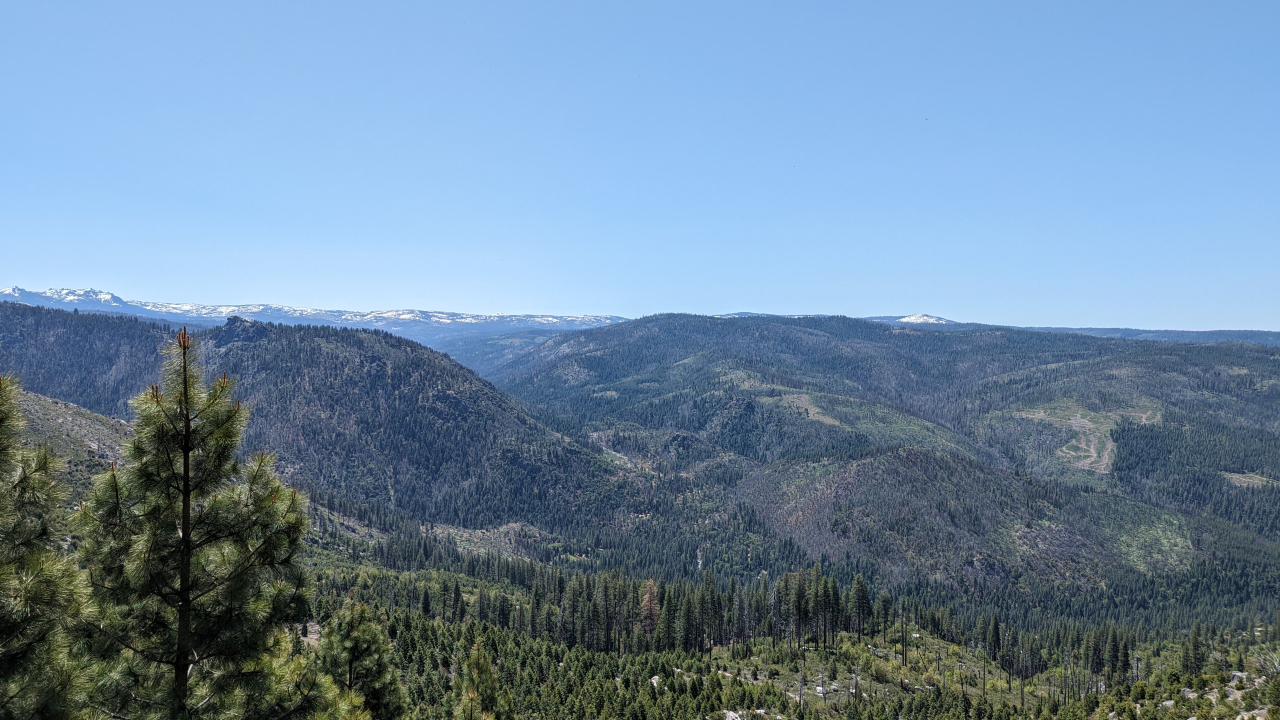
I hadn't expected to start fording creeks on day two, but here we were. It took two days before my shoes were all the way dry again.
Once I got into the Tahoe basin, I contacted my WarmShowers hosts and let them know I'd be another hour, max. It took considerably more than that. Even though I was on flat ground from there on out, I was so pooped I could barely move.
My hosts in Tahoe, Dan and Natasha, were having a potluck with their friend and thought it’d be great if I joined. And it was! Much to my delight, a lot of the dishes centered around vegetables, which is something you don’t get enough of on tour. They were surprised I lasted the whole evening instead of passing out on the bed halfway through. I was a little surprised myself.
It's worth noting that every city I visited in California had an excellent bike transportation system. As a result, you actually saw people out and about, outside of buildings and cars. You don't see that in places which discourage or prevent people from using anything but a car. Non-motor transportation, much healthier, mentally, physically, and environmentally.

Unfortunately, many of us only ever go outside to walk to and from our cars, and otherwise don't get any exercise either. The world's not so bad once you get out into it. It's becoming increasingly difficult to see the world for what it is. So many of us see the world only through the lens of a screen. It's good to watch the news, but when that's the only way you experience the world outside your house and your car, you're going to get the impression that the world is a big mean ugly, scary place, and that everyone's out to get you. It's not like that at all.
And no, it's not because California is uniquely suited for non-motor transportation. All of these cities have dramatically different landscapes and climates. The Bay area is cool and damp. The Central valley is hot and dry. Lake Tahoe is cold and snowy. Both the Bay area and Tahoe are hilly, while Davis and Sacramento are flat as a pancake. All of them have excellent bike, transportation networks. Why can't everyone else? Are you going to let Californians do something you can't?
By contrast, suburbs are ugly, boring, and extremely loud, if you ever get out of the car.

Look at this. You'll never see anyone walking around here because no one wants to be here.
I shouldn't have to say this either, but parking lots don't pay taxes, don't contribute to the local economy, and don't employ people. What a waste of space. Area is effectively the only real resource a municipality has, and they should always be trying to make the most of it. Parking lots are about the most wasteful use of space we could possibly have, and they're everywhere.

We should tax based on the space occupied by a property, rather than its current market value. That way, people would be incentivized to fill areas up with things that are actually useful, like shops, businesses, housing, and recreational space. Instead, this is where your taxes are going, and the community gets nothing in return, aside from car storage. There are eight parking spaces for every car in the United States, and that's not even counting residential street parking and People's garages. Even if everyone at the same time went somewhere and parked, almost 90% of parking spaces would still be open. We don't need so many.
To my surprise, there was a Pony Express statue in Lake Tahoe, NV, equally impressive when compared to its counterpart two days prior, but the setting wasn't the same. In Sacramento, it's in an old-fashioned historic downtown, essentially a time capsule of the wild west. In Nevada, it's in front of Harrah's Casino.
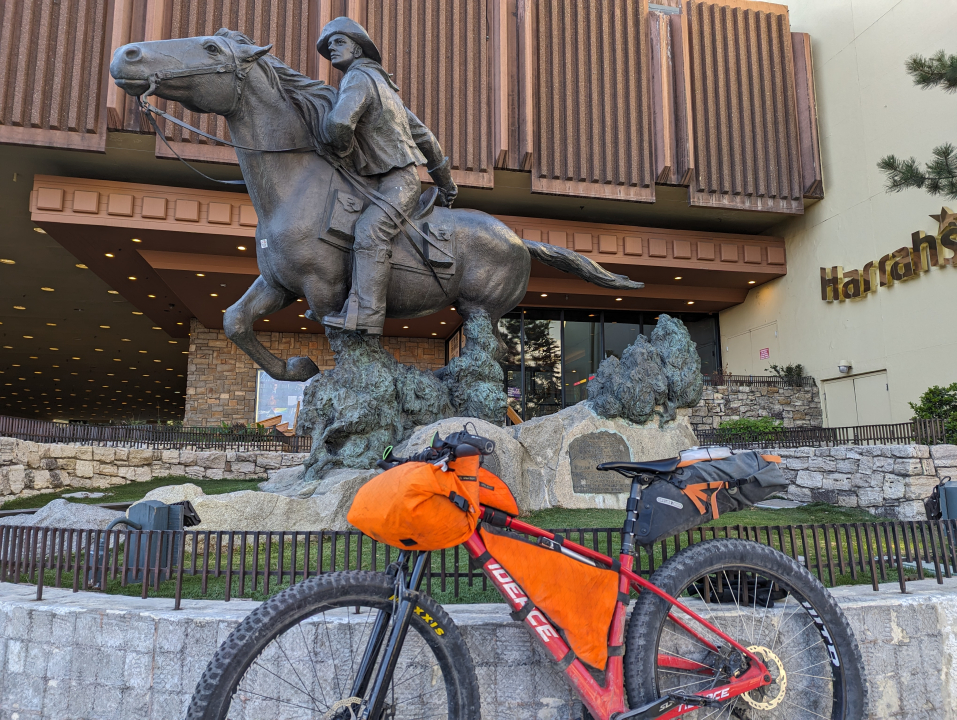
It was a reasonably good day coming out of Lake Tahoe, despite going into the wind all day. It was comforting to know that the worst hills were likely over. Up ahead, the wind was supposed to turn in my favor more often than not, at which point it ought to be smooth sailing.
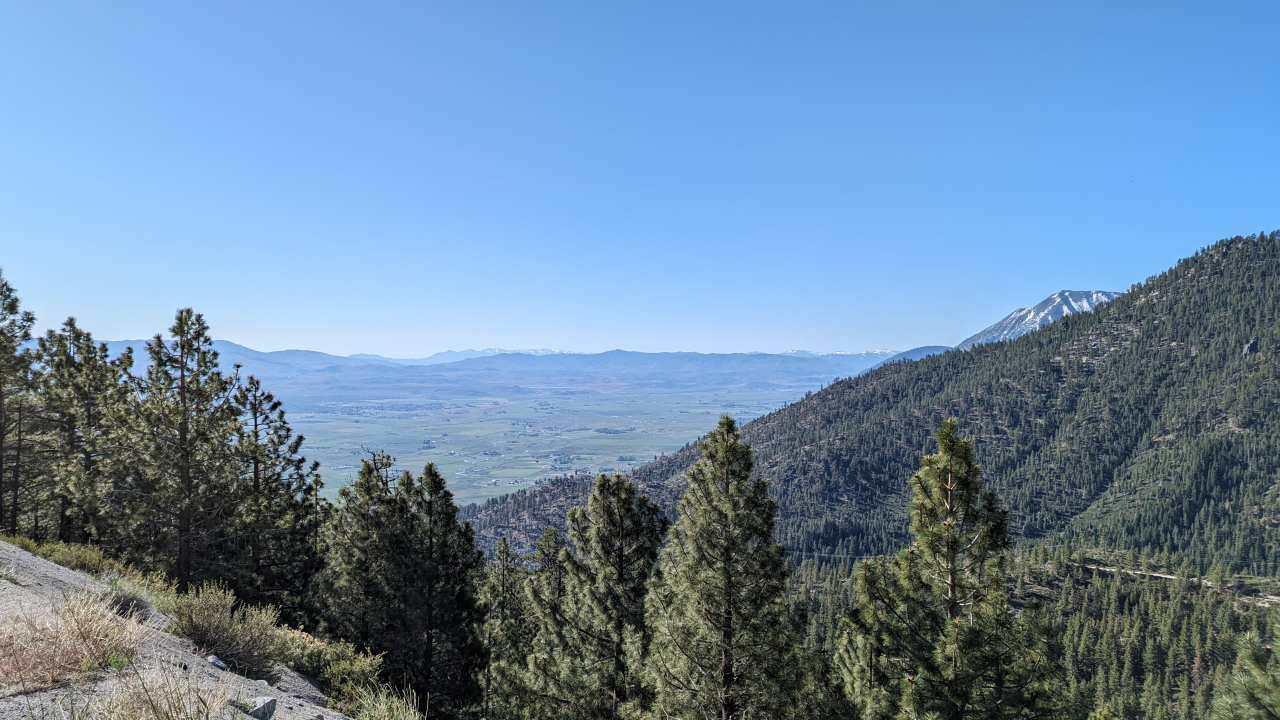
I was surprised at the widespread greenness of the first valley in Nevada, though that didn’t last. In most of Nevada, you can see towns coming from miles away; they’re islands of green dotting the parched yellow desert.
Because there was a long stretch ahead with no access to groceries, I decided to take a detour into Fallon, mostly because it gave me the opportunity to buy groceries about half a day farther into the desert. The side effect was it added distance and stayed on pavement longer.
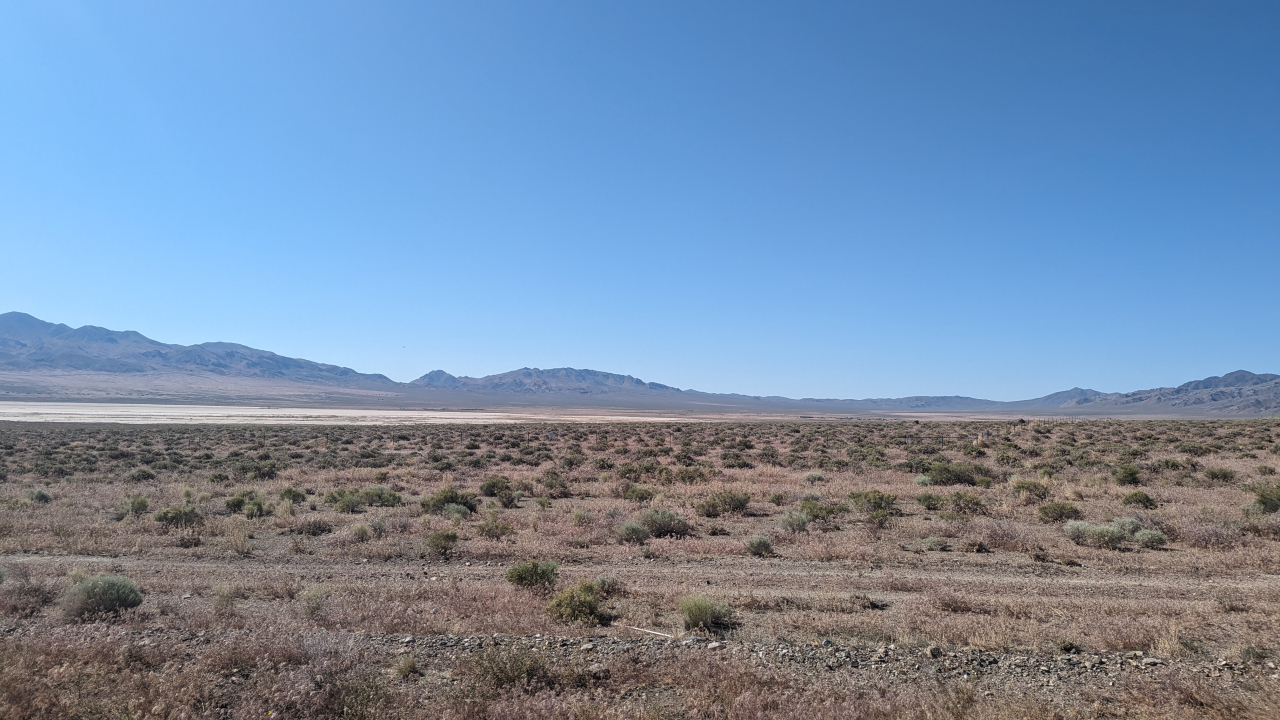
It wasn't until about 1.5 days past Lake Tahoe that I finally got back off the pavement for a good chunk of distance. This is where the bikepacking route truly began. I’d been looking forward to finally spending time on dirt roads, as the route was mostly supposed to do. And at first, I did! It was slower, but more enjoyable and fun!
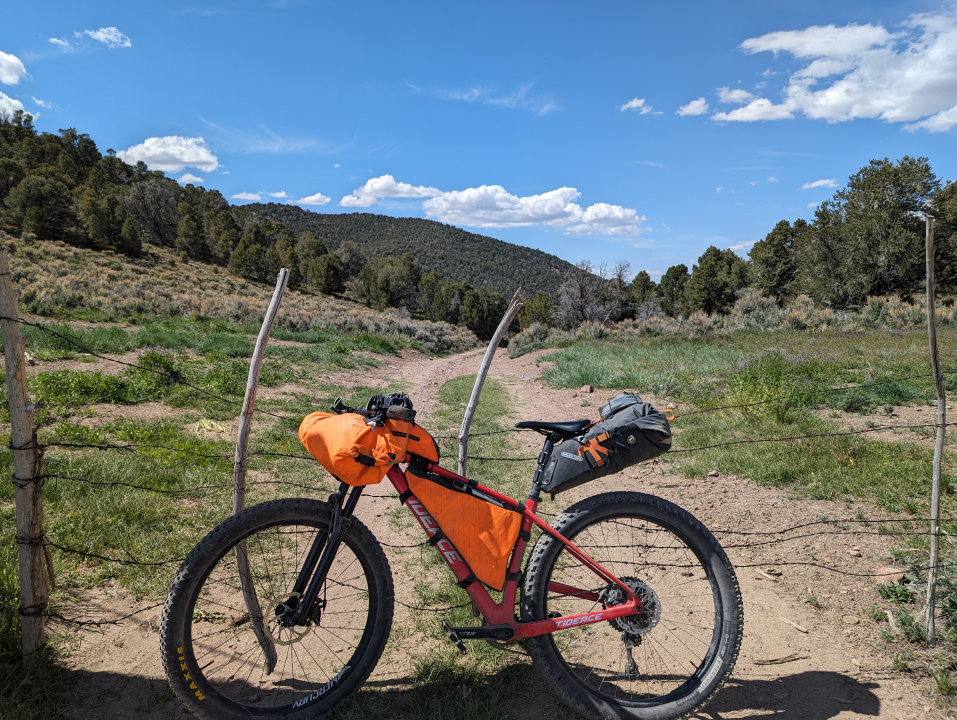
Eventually, that all changed. The dirt “road” eventually became a track of sand and rock, with a two-foot crevasse in the center. The steepness of the hill only increased as you went farther up, and that combined with the loose surface forced me to drop to my comically low gear. At times, that wasn’t enough; you’d hit one of the unusually large rocks or your tire would slip into the crevasse and your momentum would be shot. The pitch and the surface made it impossible to get started again. On these roads, it doesn’t matter how strong your legs are; you’re simply going to spin your tires. As a result, you have to walk your bike until the next spot, a little flatter or firmer, before you can start pedaling again.
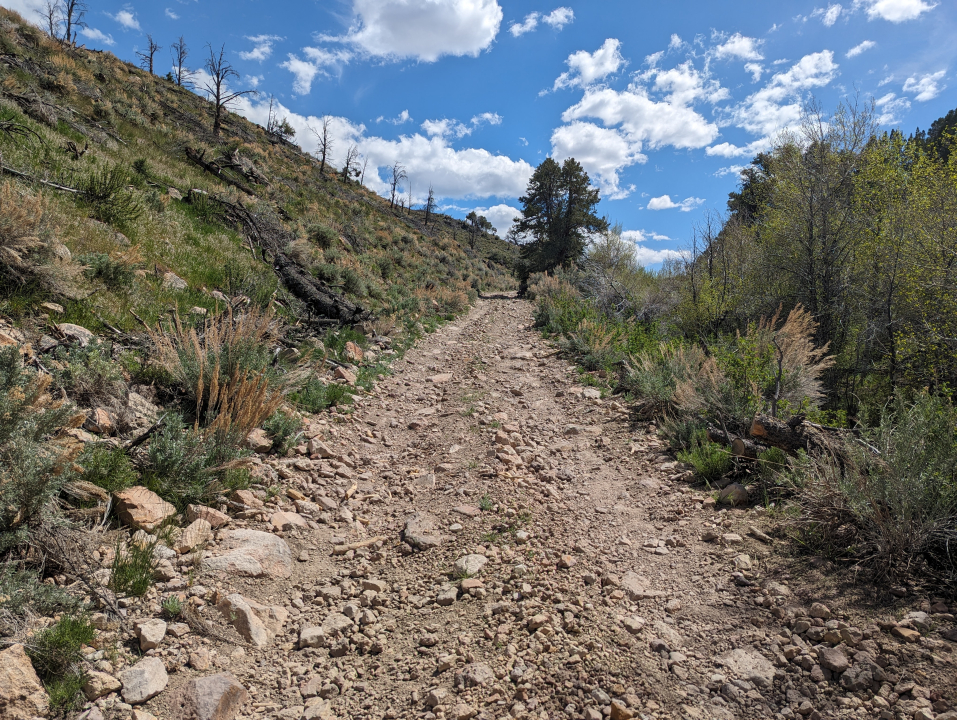
On the way down, the “road” crossed a creek several times, when it wasn't a creek itself. In all cases, the only option was to ford, sometimes on wheels, but when it was too deep, on foot. Once again, it would be a few days before my shoes were all the way dry.
The descent was too steep, loose, and rocky to get any speed going; you had to ride the brakes the whole time, which meant you didn’t even get a proper downhill reward for all the work you did on the climb. What a sham!
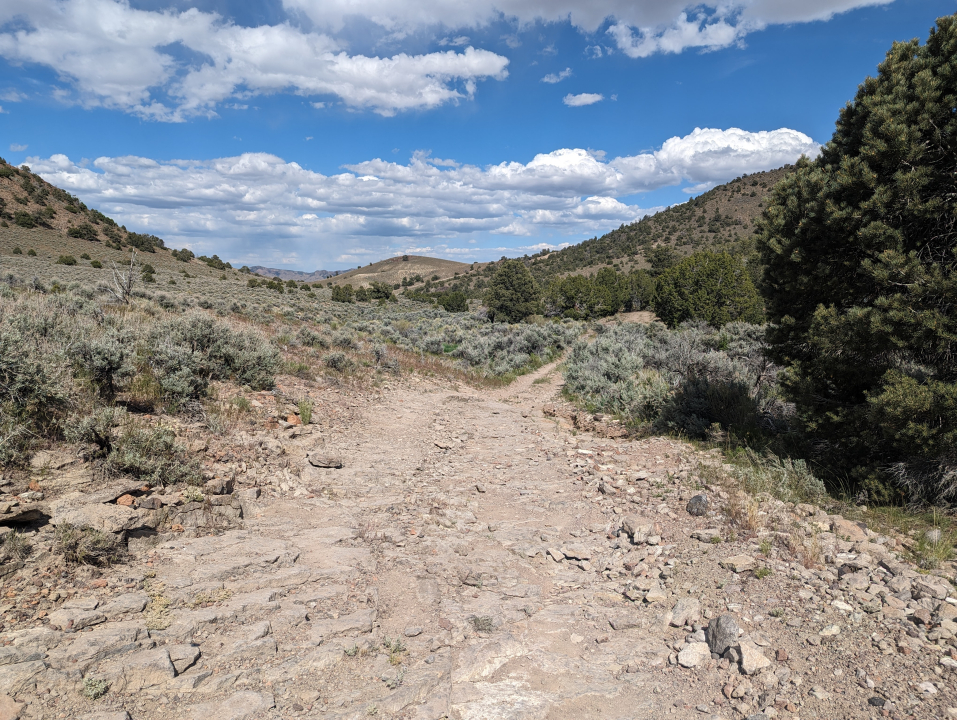
Eventually, I was dumped back onto a barely-traveled paved road, which I rode into Austin, NV, making it into town just after sunset (but not before riding through a mile-long swarm of mosquitoes). After 123 challenging miles, I decided to go ahead and get a hotel room. There, I'd meet Scott and Len, two recent retirees who were riding the Western Express route from San Francisco to Pueblo, CO, the same route I'd done seven years prior. Cool guys, and a great route they chose.
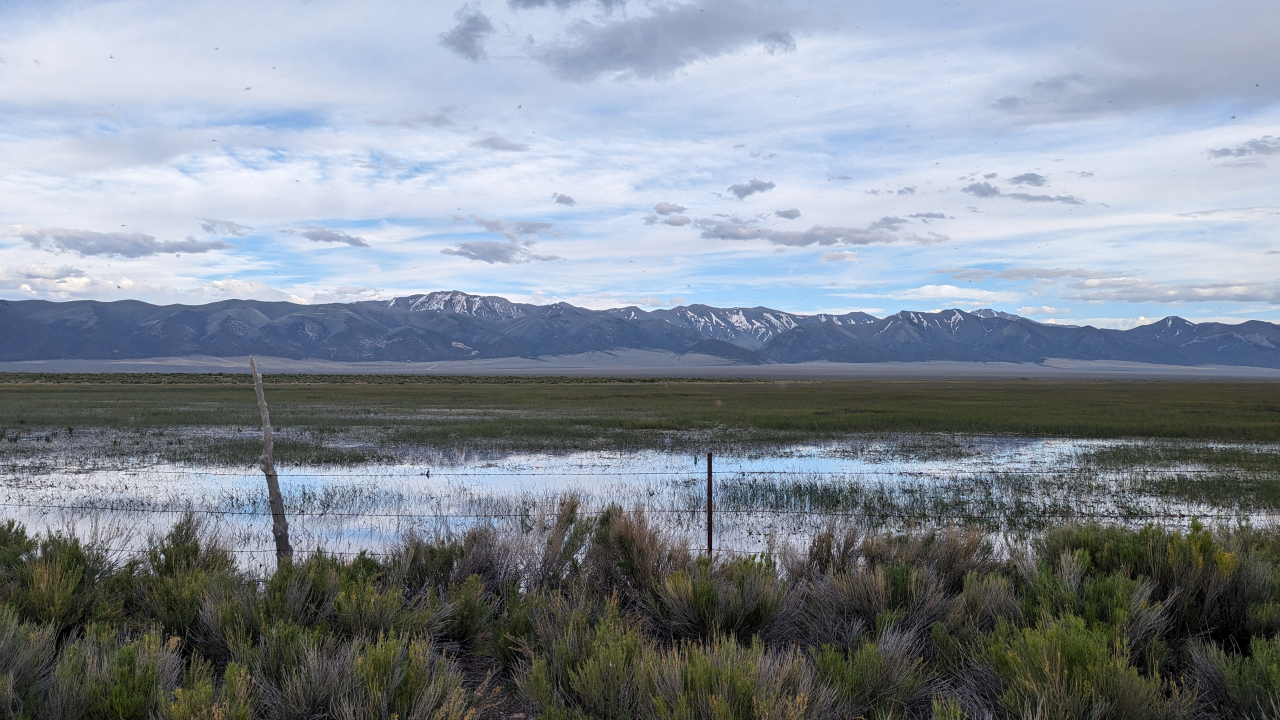
I went into my room, showered, and collapsed. Even more climbing awaited tomorrow.

Read about Coyote's adventure with his father in Central Texas. Music, food, wheels, family, all the finer things in life.
 2006
2006
 June
June
 July
July
 August
August
 2007
2007
 February
February
 2008
2008
 October
October
 November
November
 December
December
 2009
2009
 January
January
 February
February
 April
April
 June
June
 Lampasas, TX
Lampasas, TX
 Lake Whitney State Park, TX
Lake Whitney State Park, TX
 Cedar Hill State Park, TX
Cedar Hill State Park, TX
 Plano, TX
Plano, TX
 Denton, TX
Denton, TX
 Archer City, TX
Archer City, TX
 Quanah, TX
Quanah, TX
 Clarendon, TX
Clarendon, TX
 Palo Duro Canyon and Amarillo, TX
Palo Duro Canyon and Amarillo, TX
 Dalhart, TX
Dalhart, TX
 Branson, CO
Branson, CO
 Rocky Ford, CO
Rocky Ford, CO
 Manitou Springs, CO
Manitou Springs, CO
 Aurora, CO
Aurora, CO
 Fort Collins, CO
Fort Collins, CO
 Laramie, WY
Laramie, WY
 Rawlins, WY
Rawlins, WY
 Rock Springs, WY
Rock Springs, WY
 Kemmerer, WY
Kemmerer, WY
 July
July
 August
August
 2011
2011
 January
January
 April
April
 2013
2013
 February
February
 March
March
 May
May
 June
June
 July
July
 August
August
 September
September
 October
October
 November
November
 December
December
 2014
2014
 January
January
 February
February
 March
March
 May
May
 June
June
 July
July
 August
August
 September
September
 October
October
 November
November
 December
December
 2015
2015
 October
October
 2016
2016
 2017
2017
 January
January
 April
April
 May
May
 June
June
 July
July
 August
August
 September
September
 October
October
 December
December
 2018
2018
 January
January
 February
February
 March
March
 April
April
 May
May
 June
June
 July
July
 September
September
 October
October
 November
November
 December
December
 2019
2019
 January
January
 February
February
 March
March
 April
April
 May
May
 June
June
 July
July
 2020
2020
 February
February
 March
March
 May
May
 June
June
 July
July
 August
August
 September
September
 October
October
 2021
2021
 2022
2022
 2024
2024
 2025
2025